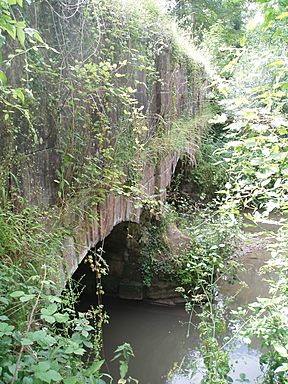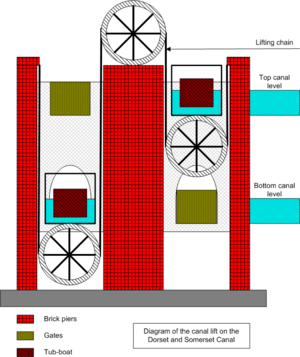Dorset and Somerset Canal facts for kids
The Dorset and Somerset Canal was a waterway planned for southwestern England. It was meant to connect Poole in Dorset with the Kennet and Avon Canal near Bradford-on-Avon in Wiltshire. Another part was planned to go from Frome to the coal-mining areas of Somerset at Nettlebridge. Building started on the coalfield branch in 1786. Instead of using traditional locks, special boat lifts were planned to move boats up and down hills. However, the company building the canal ran out of money. Work stopped in 1803, and the canal was never finished.
Contents
Planning the Canal: Early Ideas
In 1792, people started talking about building a big canal. The idea was to link Bristol and Poole. This would make it easier and safer to travel between the Bristol Channel and the English Channel. The first suggested path went through towns like Wareham, Sturminster Newton, Wincanton, and Frome. It would then join the River Avon at Bath.
The main goal was to move coal from the Mendip Hills, near Nettlebridge, southwards. Clay would also be moved northwards. A public meeting was held in Wincanton in January 1793. People began to sign up to support the project.
Choosing the Best Route
There were many ideas for the exact path the canal should take. So, a canal expert named Robert Whitworth was asked to survey a route. By September 1793, his plan showed the canal starting from the Kennet and Avon Canal at Freshford, Somerset. It would then pass through Stalbridge and head towards Blandford Forum. This new route was chosen because it had enough water to fill the canal.
Whitworth was very busy, so he suggested that William Bennet of Frome should be hired as the engineer. Bennet finished a detailed survey in 1795. He estimated the canal would cost about £200,000. Most of his plan was approved at a meeting in July. Later, short branches to Hamworthy and Wareham were added. The connection to the Kennet and Avon Canal was moved to Widbrook.
Getting Approval and Funding
When it was time to get permission from Parliament, the southern end of the canal was shortened to Shillingstone. This was done to lower the cost. An Act of Parliament was passed on March 24, 1796. This law allowed the company to raise £150,000. They could raise an extra £75,000 if needed.
However, due to changes in society and rising prices, less than £80,000 was actually raised. With this money, the company decided to start building the branch line to Frome first. They hoped to make money quickly from the coal fields and the clothing industry in Frome.
Building the Canal: What Was Achieved
Construction began on the branch line. About 8 miles (13 km) of canal were built. This section went from Stratton Common towards Frome. It passed through Coleford and Vobster.
The work included some impressive structures. One was the three-arched Murtry Aqueduct over the Mells River. This was in Vallis Vale, near Hapsford. There was also a larger aqueduct at Coleford. A tunnel at Goodeaves Farm was started but never finished.
Amazing Boat Lifts
Both the main canal and the branch line needed to go up and down hills. The law said that normal locks would be used on the main line. But for the branch, which rose 264 feet (80.5 meters), "caissons" were to be used.
The idea for these vertical boat lifts came from James Fussell IV. He owned the nearby Mells ironworks. His special design, called a balance lock, was patented in 1798. It used two tanks connected by chains over large wheels. Boats would enter one or both tanks. Each tank had an extra chamber below it. Water would fill the top tank's extra chamber, making it heavier. This weight would then cause the lift to move the boats up or down. This design was similar to successful boat lifts used later on the Grand Western Canal.
Fussell built the first boat lift at Barrow Hill. It was designed to carry 10-ton boats. It could lift them by 20 feet (6 meters). This lift was tested in September and October 1800. It was officially shown on October 13, 1800. The Bath Chronicle newspaper wrote a very positive report about it three days later.
Why Construction Stopped
Five more boat lifts were planned for the Barrow Hill section. Work started on the pits for four of them. However, the company ran out of money in 1802. About 1.7 miles (2.7 km) of canal still needed to be dug. The boat lifts were also unfinished.
The company got a second law passed by Parliament in 1803. This allowed them to raise more money. It also let them build railways instead of the canal if it was cheaper. But they could not find any more money. So, construction stopped in 1803. The Dorset and Somerset Canal was never completed.
What Remains Today
Several parts of the canal can still be seen today. There is a bridge that once carried the Edford to Stratton Common road over the canal. An aqueduct at Coleford is also still standing. It has two large arches, nearly 33 feet (10 meters) wide and just as tall.
The site of the boat lift at Barrow Hill was explored by archaeologists in 2007. The three-arched aqueduct over the River Mells at Murtry Bottom is also still there. It has about 56 feet (17 meters) of retaining wall attached to it. A project is looking into how best to protect this historical structure.
| Point | Coordinates (Links to map resources) |
OS Grid Ref | Notes |
|---|---|---|---|
| Western end | 51°14′13″N 2°28′52″W / 51.237°N 2.481°W | ST665487 | |
| Edford Bridge | 51°14′20″N 2°28′34″W / 51.239°N 2.476°W | ST668489 | |
| Coleford Aqueduct | 51°14′17″N 2°27′07″W / 51.238°N 2.452°W | ST685488 | |
| Vobster Bridge | 51°14′35″N 2°25′12″W / 51.243°N 2.420°W | ST707494 | |
| Conduit Bridge | 51°15′14″N 2°23′13″W / 51.254°N 2.387°W | ST730506 | |
| Trial balance lock | 51°14′56″N 2°22′23″W / 51.249°N 2.373°W | ST740500 | |
| Murtry Aqueduct | 51°14′49″N 2°20′31″W / 51.247°N 2.342°W | ST762498 | |
| Whatcombe Wall | 51°14′35″N 2°19′44″W / 51.243°N 2.329°W | ST771494 |



